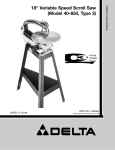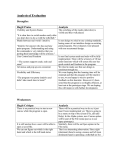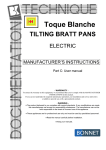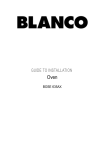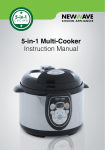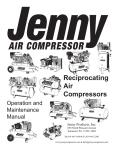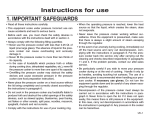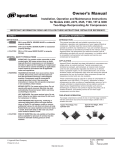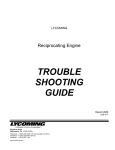Download Crestline® Dampening System Installation Instructions
Transcript
Crestline® Dampening System Installation Instructions A.B. Dick 350, 360, 375 Single & Dual Lever Machines X88-20 01/01 Rev-A GENERAL INFORMATION ATTENTION CRESTLINE® DAMPENER OWNER! Accel Graphic Systems provides parts and service through its authorized distributors and dealers. Therefore, all requests for parts and service should be directed to your local dealer. The philosophy of Accel Graphic Systems is to continually improve all of its products. Written notices of changes and improvements are sent to Accel Graphic Systems' Dealers. If the operating characteristics or the appearance of your product differs from those described in this manual, please contact your local Accel Graphic Systems Dealer for updated information and assistance. Always update your dampener when improvements are made available, especially those related to safety. YOUR AUTHORIZED CRESTLINE® DEALER IS: THE SERIAL NUMBER OF YOUR CRESTLINE® DAMPENER(S) IS: SAFETY INFORMATION 2 FOR YOUR SAFETY, DO NOT DISENGAGE OR REMOVE ANY GUARDS FROM THE CRESTLINE® DAMPENER. THE DAMPENER CONTAINS SOME INWARD ROTATING ROLLER NIPS THAT CAN CAUSE INJURY IF LEFT UNGUARDED. GENERAL INFORMATION BASIC CONFIGURATION OF CRESTLINE® b. 5/32" - 3/16" (4 - 5mm) M O P F a. 5/32" (4mm) Plate Cylinder Adjustments P M O F a. Form to Plate b. Metering to Pan TERMINOLOGY TECHNICAL ASSISTANCE Roller Description OPS = Operator's Side NOPS = Non Operator's Side = = = = Pan Metering Oscillator Form For technical assistance during the installation, please contact: ACCEL GRAPHIC SYSTEMS 11103 Indian Trail Dallas, TX 75229 PHONE (972) 484-6808 FAX (800) 365-6510 E-MAIL [email protected] WEB SITE accelgraphicsystems.com Crestline® is covered by U.S. Patents and Patents Pending 3 GENERAL INFORMATION REQUIRED TOOLS 4 1. Phillips Screwdriver 2. Standard Screwdriver 3. 3/32" Allen Wrench 4. 1/8" Allen Wrench 5. 5/32" Allen Wrench 6. 7/16" Open End Wrench 7. 1/2" Open End Wrench 8. 3/8" Open End Wrench 9. Spring Hook Tool 10. 3/32" Punch 11. Hammer GENERAL INFORMATION PRE-INSTALLATION PROCEDURES AND HOW TO PARALLEL THE DAMPENER. 1. Cut the ties holding the rollers and examine the rollers for gouges,scratches or nicks. 2. Check the box and parts boards to make sure all pieces are present and nothing has been damaged in shipment. 3. Check the dampener alignment by setting it on end on a flat surface such as a cutter bed. If dampener rocks, it needs to be realigned.Loosen the tie bar bolt and align the frames on the flat surface. Retighten bolt. 5 6 DISASSEMBLY 1 2 Remove dampener and inker guards. Remove operating handles from OPS. Remove side covers from OPS & NOPS. Remove top 2 oscillating rollers from the ink train. If press is a single lever model remove dampener activating mechanism by removing "E" ring and cap head screw (subject arrows). Loosen the lock nut holding the cap head screw before attempting to remove it. NOTE: Do not remove this mechanism on multi lever A.B. Dicks. It will be used to raise and lower the Crestline® Dampener. 3 Remove vertical tension springs at OPS & NOPS (subject arrow). 7 8 DISASSEMBLY 4 Remove tie bar bolt (subject arrow) from dampener frame at OPS & NOPS. 5 Remove water lock out bracket (subject arrow) at OPS & NOPS. Brackets are short pieces of metal, each retained by 2 cap head bolts. 6 The metering roller assembly can now be removed by holding the tie bar (subject arrow) and pulling the mechanism out towards the ink rollers. 9 10 DISASSEMBLY 7 8 9 Remove copper pan roller by loosening the 2 set screws on each collar at the OPS & NOPS and moving them toward the center of the press. There may be a small snap ring that holds the collar in place, if so, remove the snap ring before attempting to remove collar. Remove bolt in the oscillator housing nearest the feed at OPS & NOPS. Also remove the 2 screws that hold the lift shaft housing at OPS (subject arrows). Remove gear guard from the plate cylinder. NOTE: Replace nut (subject arrow) immediately after removing guard. 11 12 DISASSEMBLY 10 Remove large stud from OPS that held the water activating mechanism. Remove the screw holding the dampener frame on the OPS. 11 Unhook the spring attached to the water ductor arm (located near subject arrow) at both OPS & NOPS. 12 Remove dampener frame from OPS. The shaft between the frames is removed with the OPS frame as one piece. 13 14 DISASSEMBLY 13 Drive the TAPER PIN (make sure to hit the small end) out of the lift shaft gear & remove the gear and shaft housing from the OPS (subject arrow). 14 Remove the two nut and bolt combinations (subject arrow) at NOPS. Remove any other nut and bolt combinations that may secure the frame to the NOPS. 15 Remove the "E" rings on the lift shaft at the OPS & NOPS ("E" rings near subject arrow), push arms in toward the center and remove the shaft assembly. 15 16 DISASSEMBLY 16 17 18 Remove the NOPS dampener frame by loosening the collar on the plate cylinder shaft (subject arrow). Gently tap the plate cylinder toward operator side until there is enough clearance to pull out frame. Once the frame is removed, pull cylinder back toward NOPS and retighten set collar in its original position. On single lever models, remove night latch link (subject arrow), saving E-rings, washers, and spring for reinstallation. Clean insides of press frames thoroughly with solvent and a rag. OPTION: You can remove the tie bar that holds the water lockout brackets. Remove the bracket assembly from the tie bar and return the tie bar to its original position. YOU ARE NOW READY TO INSTALL CRESTLINE®. 17 18 INSTALLATION 1 2 3 On newer model 360's & 375's, the installation of an adapter plate (left hand picture) may be required at the OPS. The plate covers a cut out in the press. Install the plate as shown. The bottom of the hole in the plate aligns with the small depression in the cut out (subject arrow) If the press frame does not have this cutout, discard the adapter plate and proceed to the next step. Install water form adjusting mechanism at OPS & NOPS by inserting the spring stud through mechanism and then through the vacant hole in the ink oscillator housing (the original bolt was removed in disassembly step 8). On some very early models, this hole is too small and must be drilled out to 1/4". Angle the mechanism toward the delivery end of the press and finger tighten nut. THIS STEP FOR SINGLE LEVER MACHINES ONLY! DUAL LEVER INSTRUCTIONS ON NEXT PAGE. Install lift shaft by inserting the longer portion that extends past the cams into the 5/8" hole in the OPS then dropping the shaft down into the press and through the same hole at NOPS. DO NOT MOVE CAMS TO INSTALL THE SHAFT. Slide on the bronze bearings (subject arrow) at each end of the shaft with the flange to the outside, and press into the frame. Light tapping around bearing flange is usually sufficient to seat it. (On some early models, the hole at the NOPS is only 1/2" and therefore a bearing is not used). Once bearings are seated, slip set collar on each end of the shaft but do not tighten at this time. PROCEED TO STEP 4 19 20 INSTALLATION THIS STEP FOR DUAL LEVER MODELS ONLY! Remove gear from end of lift shaft. Insert gear end of shaft through the 5/8" hole in the OPS then dropping the shaft down into the press and through the same hole at NOPS. DO NOT MOVE CAMS TO INSTALL THE SHAFT. Slide on the bronze bearings (subject arrow) at each end of the shaft with the flange to the outside, and press into the frame. Light tapping around bearing flange is usually sufficient to seat it. (On some early models, the hole at the NOPS is only 1/2" and therefore a bearing is not used). Once bearings are seated, slip set collar on each end of the shaft but do not tighten at this time. PROCEED TO STEP 4. 4 Sit the dampener down in between the side frames making sure gears mesh. 5 Insert mounting studs through the dampener & into the vertical slot in the press frame or hole in the adapter plate previously installed. 21 22 INSTALLATION 6 Position lift shaft side to side so the cams are spaced equally between the bearings on the hanger brackets and lock the position of the lift shaft with the set collars. The flat portion of the cam should be facing up (subject arrow) in the neutral position. 7 Push down on dampener, making sure it seats at the bottom of the slot or hole at both OPS & NOPS and fully tighten bolts. Slip washer over cap head bolt. 8 Position water form adjusting mechanism at OPS & NOPS (subject arrow) so they are parallel with the dampener frame as shown and fully tighten nut on outside of press frame. 23 24 INSTALLATION 9 10 Install springs between dampener spring stud and the spring stud in the water form adjusting mechanism (subject arrow). THIS STEP FOR SINGLE LEVER MACHINES ONLY! Replace the night latch link on the press with the new linkage provided by Accel (lower subject arrow). Picture is shown with single lever on the water off or night latch position. If the linkage is installed pre-assembled (as shown in picture), you will slip the control block (upper subject arrow) over the lift shaft as you connect the linkage in the same manner as the original one. Use the new sequence cam spring provided by Accel. PROCEED TO STEP 11 - SINGLE LEVER MACHINES. THIS STEP FOR DUAL LEVER MACHINES ONLY! Slip provided stop bolt through slot in dampener activating lever approximately 3/4" from the end (right hand subject arrow). Secure with provided washer and nut. Move the activating lever all the way to the right and against the top screw. Slip gear (left hand subject arrow) over end of the lift shaft and engage teeth with activating lever. Rotate lift shaft until the flats on the cams are facing up and perfectly horizontal (parallel to floor). Tighten set screw in gear to secure it to the lift shaft. NOTE: Picture shown with original shaft housing in place. This was replaced in step 3 with a bronze bushing. PROCEED TO STEP 11 FOR DUAL LEVER MACHINES. 25 26 INSTALLATION 11 THIS STEP FOR SINGLE-LEVER MACHINES ONLY! Place the single lever in the "water on" position (2nd detent). Rotate the lift shaft clockwise until the cams contact the ball bearing on the dampener hanger brackets. Holding the shaft in this position, tighten the set screws in the control block (subject arrow). Return the single-lever shaft to the off position. The cams should rotate clockwise and the ball bearings on the dampener hanger brackets should rest over the "corner" of the cam. NOTE: If you rotate the lift shaft too far it can affect the stripe between the form roller and metering roller. YOU ARE NOW READY TO MAKE FINAL ADJUSTMENTS. CONTINUE TO NEXT PAGE. THIS STEP FOR DUAL-LEVER MACHINES ONLY! Slide the activating lever back all the way to the left while watching the lift cams rotate clockwise under the ball bearings on the dampener. When the corners of the cams pass just under the bearings, you should be able to let go of the activating lever without it springing back to the right. If this does not operate correctly, you must reposition the stop bolt (from previous step) and reposition gear on lift shaft. You may also have to increase the spring tension on the activating lever by tightening nut on compressions spring behind lever. YOU ARE NOW READY TO MAKE FINAL ADJUSTMENTS. CONTINUE TO NEXT PAGE. 27 28 FINAL ADJUSTMENTS 1 2 O M F P 5/32" Plate Cylinder 3 O M F P 3/16" Plate Cylinder FORM ROLLER LIFT AND GEAR MESH Place single lever in night latch (off for multi lever machines) position and mount a plate to the press. Adjust set screws on the dampener frame tie bar (subject arrow) until you have an equal .050" - .060" of lift between form roller and plate cylinder. Turning the screws down increases the gap between the form roller and plate cylinder and vice-versa. There should also be a gap between the metering roller and the form roller. After proper lift is obtained, tighten lock nuts. FORM ROLLER TO PLATE CYLINDER PRESSURE Dab some ink on the oscillator and turn on the press. Move the single lever to the Neutral ("On" for multi lever machines) position to distribute the ink on the dampener. Place the dampener in the "Night Latch" position and turn off the press. Lower the dampener to the plate and back off again. This will leave a stripe. The proper setting is an even 5/32" across the plate. Adjust the stripe by turning the bolts (subject arrow) in the water form adjusting mechanism. Turning the bolts down drops the dampener and makes a wider stripe. Adjust it to 5/32" stripe to the plate and tighten lock nuts against adjusting mechanism. MAXIMUM METERING TO PAN ROLLER PRESSURE Place the single lever dampener in the "Night Latch" position. Spin the ratchet gears down until they stop against the cross bar. (They are not yet locked to knobs). Turn the press on and let the press idle for 20 seconds. Check the stripe between the pan the metering rollers. It should be 3/16". Adjust by turning the knurled knobs. Turning the knobs down makes a wider stripe. Once the stripe is correct, lock the ratchet gears to the knobs by tightening the set screws (2 each). This position sets minimum water. Installation of Crestline® results in the following changes in the single lever positions: 1. Night latch becomes the "Off" position. 2. Neutral becomes the "Water On" position. 3. Ink & Water position drops the ink forms to the plate. 29 30 GUARD INSTALLATION 1 2 3 Attach the guard mounting brackets to the press frames utilizing the two existing holes (subject arrows left photo NOPS shown) in each frame. The brackets attach to the outside of the press frames using the provided 1/4-20 x 1/2 button head bolts and flanged lock nuts. In the right photo (shown from NOPS side), note how the angled side of the mounting bracket is towards the feeder side of the press. On 375 model presses the two piece mounting bracket goes on the NOPS. Attach the tie bar to the lower hole (subject arrow) in the mounting brackets using 1/4-20 x 3/8 button head bolts. Use the NOPS bolt to also secure the hose clamp. Install the pivot sleeve in the NOPS mounting bracket using the large e-ring to secure it. 31 32 GUARD INSTALLATION 4 5 6 Set the inker and dampener guard on the press and align the holes in the tabs on the top of the guards. From the NOPS slide the pivot rod through the mounting bracket and guards into the OPS mounting bracket. Secure the shaft with the small E-ring (subject arrow) on the NOPS. Locate the two holes, one each at the OPS and NOPS (lower subject arrow). If you do not have this hole, drill a 9/32" diameter hole 1 3/8" straight down from the hole above it (upper subject arrow). See also "A.B. Dick 360/375 Side Frame Modification" diagram on page 42. Install the plate/blanket guard in the press and slide the hinge blocks (subject arrow), located in the lower corners of the guards, into the holes in the press frames from the previous step. Tighten the bolts after centering the guard in the press. 33 34 GUARD INSTALLATION 7 If the inker and dampener guards are not square in the press they can be adjusted by loosening the bolts securing the mounting brackets to the press frames and twisting them as shown in the diagram until they are square. The installation of the guards is now complete. However, if your press originally came equipped with safety switches, proceed with the remaining steps to insure their continued operation. If your press originally came with safety switches but some are missing or not functioning properly, refer to the diagram on page 43 for the part numbers to order from your A.B. Dick dealer. 8 Remove the magnet from the original inker guard and install it on the new one (subject arrow). 9 Install the provided plunger (subject arrow) on the NOPS of the dampener guard and position it as necessary to reach the microswitch on the press frame. 35 36 GUARD INSTALLATION 10 11 Install a magnet from one of the original plate guards on the supplied “L” shaped bracket. Attach this bracket to the OPS side of the new plate guard so that it switches with the old lower plate guard switch. Remove the female connectors from the ends of the wires that went to the read switch that was removed to install the dampener. Strip 3/16" from the ends of the wire and crimp together using the supplied butt connector. 37 BASIC OPERATION START OF DAY A. Make sure the oscillator and metering rollers are in place. B. Spin knurled knobs until the shoulder on the ratchet stops against the bar. C. Mount plate to cylinder. Wipe down all plates before running. Pre-ink the Crestline® dampener before running the plates with an extremely light coverage of ink. Dab the ink on the oscillator only. D. Place water bottle in bracket. NOTE: Accel recommends using the proper fountain solution for the plate material being run on the press. A good acid/gum etch should be used with metal plates. RUNNING DURING THE DAY A. In general, the Crestline® Dampener should not have to be adjusted from job to job. The form roller setting should never be changed unless it has deviated from the factory specification of 5/32" to the plate. B. Adjustments to the amount of water fed to the plate are made by the knurled knobs that apply pressure to the metering roller. The dampener has been set up for minimum water. To increase the water to the plate, turn the knurled knobs counterclockwise 1 or 2 clicks at a time. This opens the gap between the metering and pan rollers and allows more water to the plate. C. In general, more water will only be required when going from a metal plate to an electrostatic or Silvermaster type plate. 38 CLEANING & MAINTENANCE WASH UPS DURING THE DAY 1. Remove bottle and drain the excess water from the pan. 2. Mount cleanup mat to the press or if applicable, a wash-up attachment along with a metal plate to act as a bridge between dampener and inker. 3. Turn on the press and squirt a small amount of press wash on the ink and dampener rollers. (Squirt ink rollers only if using a wash-up attachment.) 4. Drop both the dampener and ink forms to the plate. If using an attachment, generally the dampener will pick up enough roller wash off the plate to clean itself, so apply wash directly to the dampener only when necessary. 5. Remove water pan and clean any solution left in it. 6. Be sure to wipe excess clean up solution from the ends of the dampener metering and pan rollers. END OF THE DAY 1. Wash up dampener. Pay close attention to cleaning the ends of the pan and metering rollers that extend past the form rollers. 2. Spin the knurled knobs up until the metering roller can be removed. 3. Remove metering roller and wipe down thoroughly to remove any excess wash that may be on the roller. 39 CLEANING&&MAINTENANCE MAINTENANCE CLEANING DEGLAZING THE DAMPENER OILING AND GREASING THE DAMPENER 40 Periodic deglazing of water-soluble contaminants will be necessary with the Crestline®. Typically, once every 2-3 weeks will be sufficient, unless you are running electrostatic plates on a daily basis whereas deglazing should be performed weekly. A 50/50 solution of household ammonia and hot water can be used for deglazing purposes. If you prefer a commercially available deglazer, avoid those containing pumice or gritty substances. Always follow deglazing with straight water and then roller wash. Accel offers a product called COMPOUND X that we recommend for deglazing our system. Contact your dealer or Accel for more information. A. Place a small amount of grease on the gears once a month. B. Inject grease into the oscillator grease fitting once a month. CLEANING AND MAINTENANCE CRESTLINE® CLEANING & MAINTENANCE CHART Daily Weekly Bi-Weekly Monthly Wash Rollers Deglaze Rollers Metal Plate Users Silvermaster Plate Users Electrostatic Plate Users Grease Gears Inspect Ball Bearings Check Roller Pressures Check Roller Surfaces 41 SIDE FRAME MODIFICATION 42 SAFETY SWITCH REPLACEMENT PARTS 43 A.B. DICK 350 / 360 (NOPS) 44 A.B. DICK 350 / 360 (OPS) 45 A.B. DICK 350 / 360 46 A.B. DICK 350 / 360 47 A.B. DICK 350 / 360 48 A.B. DICK 350 / 360 49 A.B. DICK 350 / 360 50 A.B. DICK 350 / 360 51 A.B. DICK 360 DUAL LEVER 52 A.B. DICK 350 / 360 53 A.B. DICK 375 54 A.B. DICK 375 55 A.B. DICK 375 56 A.B. DICK 375 57 A.B. DICK 375 58 A.B. DICK 375 59 A.B. DICK 375 60 A.B. DICK 375 61 A.B. DICK 375 62 11103 Indian Trail, Dallas, TX 75229 Phone 972-484-6808, Fax 800-365-6510 E-Mail [email protected], Web Site www.accel-us.com

































































